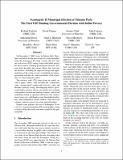Scantegrity II Municipal Election at Takoma Park: The First E2E Binding Governmental Election with Ballot Privacy
Author(s)
Carback, Richard T.; Chaum, David; Clark, Jeremy; Conway, John; Essex, Aleksander; Herrnson, Paul S.; Mayberry, Travis; Popoveniuc, Stefan; Rivest, Ronald L.; Shen, Emily (Emily Huei-Yi); Sherman, Alan T.; Vora, Poorvi L.; ... Show more Show less
DownloadRivest_Scantegrity II.pdf (530.6Kb)
OPEN_ACCESS_POLICY
Open Access Policy
Creative Commons Attribution-Noncommercial-Share Alike
Terms of use
Metadata
Show full item recordAbstract
On November 3, 2009, voters in Takoma Park, Maryland,
cast ballots for the mayor and city council members
using the Scantegrity II voting system—the first time
any end-to-end (E2E) voting system with ballot privacy
has been used in a binding governmental election. This
case study describes the various efforts that went into
the election—including the improved design and implementation
of the voting system, streamlined procedures,
agreements with the city, and assessments of the experiences
of voters and poll workers.
The election, with 1728 voters from six wards, involved
paper ballots with invisible-ink confirmation
codes, instant-runoff voting with write-ins, early and
absentee (mail-in) voting, dual-language ballots, provisional
ballots, privacy sleeves, any-which-way scanning
with parallel conventional desktop scanners, end-to-end
verifiability based on optional web-based voter verification
of votes cast, a full hand recount, thresholded authorities,
three independent outside auditors, fully-disclosed
software, and exit surveys for voters and pollworkers.
Despite some glitches, the use of Scantegrity II was
a success, demonstrating that E2E cryptographic voting
systems can be effectively used and accepted by the general public.
Date issued
2010-08Department
Massachusetts Institute of Technology. Computer Science and Artificial Intelligence Laboratory; Massachusetts Institute of Technology. Department of Electrical Engineering and Computer ScienceJournal
UNIX Security Symposium. Proceedings 19th USENIX Security Symposium, 2010
Publisher
USENIX Association
Citation
Carback, Richard et al. "Scantegrity II Municipal Election at Takoma Park:
The First E2E Binding Governmental Election with Ballot Privacy" Proceedings of the 19th USENIX Security Symposium, 2010, Washington, D.C., Aug. 11-13, 2010.
Version: Author's final manuscript